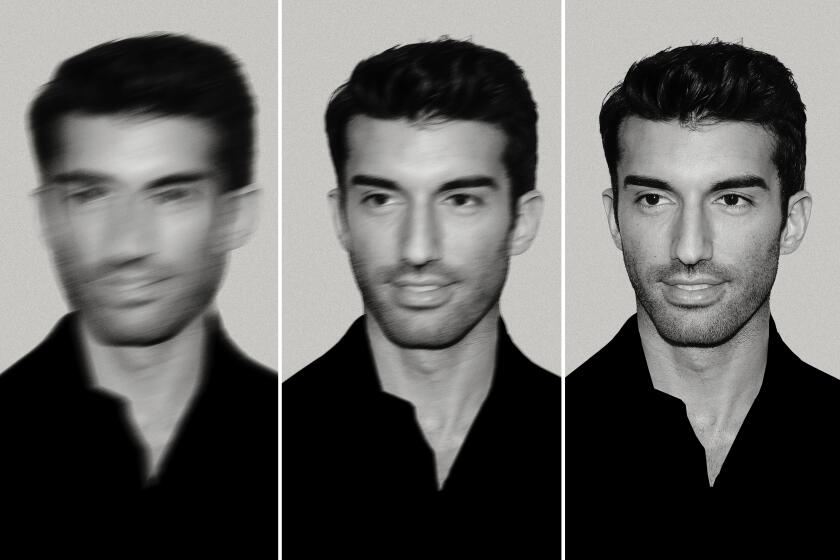MOVIE REVIEW : Spike Lee’s ‘We Cut Heads’ Foretells Great Things : The movie maker’s first film, produced in 1982, covers about the same ground as ‘Do The Right Thing’ and is sometimes clumsy but revealing. It will screen tonight at UC Irvine.
- Share via
The Bedford-Stuyvesant in Spike Lee’s “Do The Right Thing” is a barbed mesh of races: Edgy black youths mingle with their soft, resigned elders on the corner, all of them mixing uneasily with the few whites and Asians who have built lives in this Brooklyn neighborhood.
It’s a different vision than what Lee offered in his first full-fledged movie, the hourlong “Joe’s Bed-Stuy Barbershop: We Cut Heads,” made seven years earlier in 1982 while he was a graduate student at New York University. The Bed-Stuy here is all black; Lee’s camera pans over the graffiti-marked avenues and alleys to find blacks dealing with the pressures that they place on themselves. Whitey seems like a distant concern.
It makes sense that “We Cut Heads”--to be screened tonight by UC Irvine’s 24 Frames Per Second film society--has a narrower focus. This often clumsy but revealing movie keeps its ambition reined in. Later on, as Lee’s experience and talents grew, his foundation was solid enough to engage the race-relations issue in the more expansive and provocative “Do The Right Thing.”
What’s intriguing about “We Cut Heads” is not the simple, linear story of Zack (played by the almost expressionless Monty Ross) and his running afoul of black mobsters, but the linkages between Lee’s immature style and the more advanced movie-maker he has become. There are seeds, both thematically and cinematically, in the early film that later sprouted in “Do The Right Thing.”
The ending in “We Cut Heads” pivots on violence and arson, the same as in “Do The Right Thing.” Lee’s take is more ambiguous as Zack, who has stolen the mob’s numbers money to make a better life for his family, awaits its revenge in his barbershop. He’s spent the night reflecting on what a man would do, and he is determined to do the right thing and face them down. The threat of fire tempers him.
At the close of “Do The Right Thing,” the white-owned Sal’s Famous Pizzeria is torched when black rage and racism ignite. The event has been justly criticized as dangerous, shallow and sensational, but as a symbol, it has resonance. The blaze tempers here as well, lessening, at least temporarily, the tensions in Bed-Stuy and allowing Sal and Mookie to forge a tenuous truce. While contrived, the scene nonetheless underscores Lee’s recurring theme of violence as a fact of life in the big cities.
The first moments in “We Cut Heads” are likewise crudely shocking. Joe, Zack’s partner, is murdered by gang hit men after he tries to steal the mob’s money. Lee’s photographer, Ernest Dickerson, lingers on Joe as he’s tied up, bricks stuck in his coat pockets, and tossed in the river.
Later, when Zack is forced to accept the same deal Joe had, namely to employ the barbershop as a front for the numbers game, we are treated to close-ups of thugs pounding on Zack. The blood and bruises are missing in “Do The Right Thing,” but the same in-your-face camera work is used, although more gracefully and controlled.
Lee’s reliance on music for distinctive mood also shows up in “We Cut Heads.” As usual, much of the soundtrack was composed by his father, Bill Lee; here, it has a vaguely sad, out-of-sync quality that may or may not have been intentional. Whatever, the effect comes close to being foreshadowing--not explosive like his use of MTV sound with the occasional MTV image employed in his later movies but more casual.
Perhaps Lee’s most accessible trait is his naturalistic humor that comes across as throwaway but actually is dynamic. In the movie’s most amusing, and probably affecting, scene, Zack plays checkers with his young assistant, Teapot (Stuart Smith), and they talk about hairstyles.
Teapot knows that a look can make the young black on the move, and he can’t understand why Zack refuses to increase business by doing voguish wild cuts and processes. Zack thinks blacks should be more natural; “Processes ruin the hair and the brain too. That’s why we’ve got so many dumb niggers,” he tells the boy. Teapot immediately grasps that they’re talking about pride and African roots.
Later, in another fetching scene, Teapot reverts to form and gives a little street lesson to a tiny friend. He talks tough, jive and dirty, and the kid mimics him. Both segments, shot in a direct, simple way, tell much about the ritualistic passing of knowledge and gaining of identity.
Lee contrasts these lighter passages with hard images of the blacks who prey on other blacks. The fancy-man mob boss, Nicholas Lovejoy (Tommie Hicks, who also appeared in “She’s Gotta Have It”), talks with the sway of a preacher about the opportunities created by the numbers: “I give hope, I make dreams real. What I’m talking about is unity.” But Zack knows that’s a lie, and his face, usually so blank, is full of contempt for this exploiter.
Very nice, these scenes. Make no mistake, though; “We Cut Heads” is not a great movie and certainly not a refined one. It is an accomplished low-budget effort that, while betraying the errors and sentimentality of young art, also documents the craftsmanship and lyrical energy of a movie-maker soon to be reckoned with.
Spike Lee’s “Joe’s Bed-Stuy Barbershop: We Cut Heads” will be presented at 7 p.m. Saturday at Humanities Hall Room 178 on the UC Irvine Campus. Tickets: $2 and $4. Information: (714) 856-7418.
More to Read
Only good movies
Get the Indie Focus newsletter, Mark Olsen's weekly guide to the world of cinema.
You may occasionally receive promotional content from the Los Angeles Times.










